NISSAN 370Z COUPE 2011 Owner's Guide
Manufacturer: NISSAN, Model Year: 2011, Model line: 370Z COUPE, Model: NISSAN 370Z COUPE 2011Pages: 419, PDF Size: 3.61 MB
Page 31 of 419
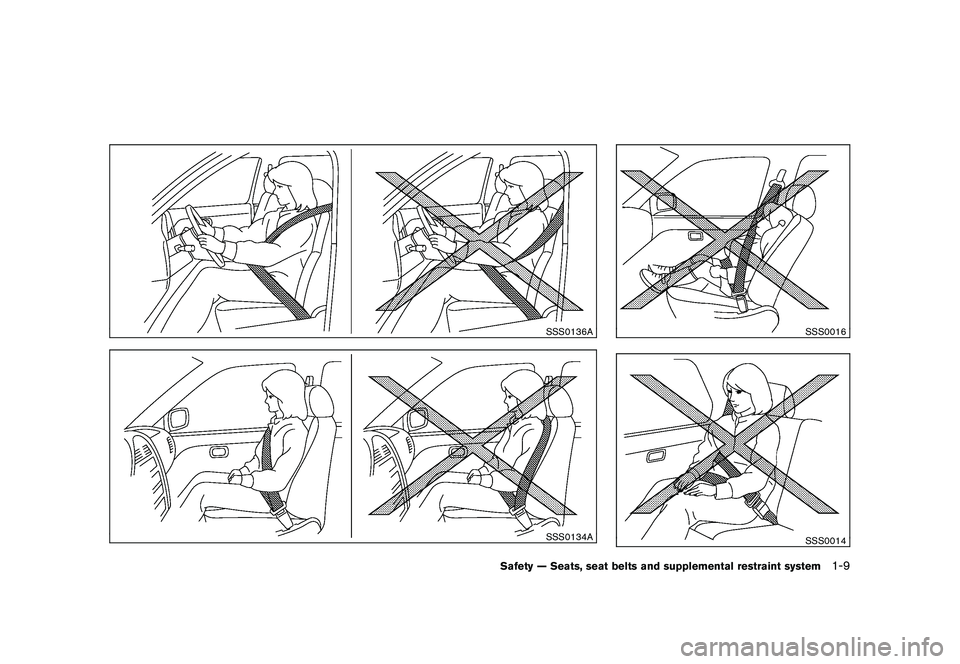
Black plate (27,1)
Model "Z34-D" EDITED: 2010/ 7/ 27
SSS0136ASSS0134A
SSS0016SSS0014
Safety — Seats, seat belts and supplemental restraint system
1-9
Page 32 of 419
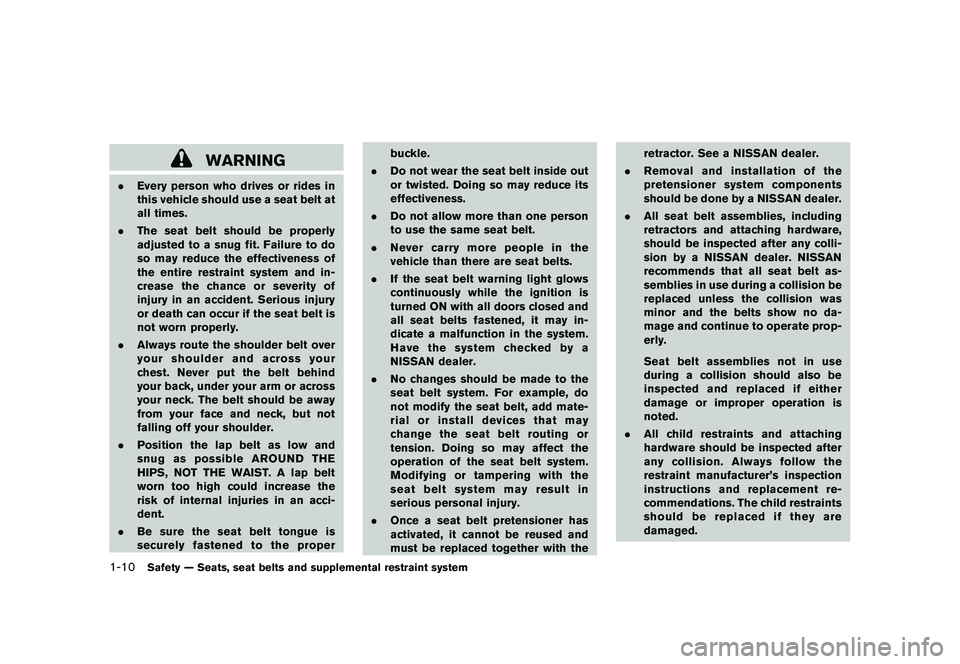
Black plate (28,1)
Model "Z34-D" EDITED: 2010/ 7/ 27
WARNING
.Every person who drives or rides in
this vehicle should use a seat belt at
all times.
. The seat belt should be properly
adjusted to a snug fit. Failure to do
so may reduce the effectiveness of
the entire restraint system and in-
crease the chance or severity of
injury in an accident. Serious injury
or death can occur if the seat belt is
not worn properly.
. Always route the shoulder belt over
your shoulder and across your
chest. Never put the belt behind
your back, under your arm or across
your neck. The belt should be away
from your face and neck, but not
falling off your shoulder.
. Position the lap belt as low and
snug as possible AROUND THE
HIPS, NOT THE WAIST. A lap belt
worn too high could increase the
risk of internal injuries in an acci-
dent.
. Be sure the seat belt tongue is
securely fastened to the proper buckle.
. Do not wear the seat belt inside out
or twisted. Doing so may reduce its
effectiveness.
. Do not allow more than one person
to use the same seat belt.
. Never carry more people in the
vehicle than there are seat belts.
. If the seat belt warning light glows
continuously while the ignition is
turned ON with all doors closed and
all seat belts fastened, it may in-
dicate a malfunction in the system.
Have the system checked by a
NISSAN dealer.
. No changes should be made to the
seat belt system. For example, do
not modify the seat belt, add mate-
rial or install devices that may
change the seat belt routing or
tension. Doing so may affect the
operation of the seat belt system.
Modifying or tampering with the
seat belt system may result in
serious personal injury.
. Once a seat belt pretensioner has
activated, it cannot be reused and
must be replaced together with the retractor. See a NISSAN dealer.
. Removal and installation of the
pretensioner system components
should be done by a NISSAN dealer.
. All seat belt assemblies, including
retractors and attaching hardware,
should be inspected after any colli-
sion by a NISSAN dealer. NISSAN
recommends that all seat belt as-
semblies in use during a collision be
replaced unless the collision was
minor and the belts show no da-
mage and continue to operate prop-
erly.
Seat belt assemblies not in use
during a collision should also be
inspected and replaced if either
damage or improper operation is
noted.
. All child restraints and attaching
hardware should be inspected after
any collision. Always follow the
restraint manufacturer’s inspection
instructions and replacement re-
commendations. The child restraints
should be replaced if they are
damaged.1-10
Safety — Seats, seat belts and supplemental restraint system
Page 33 of 419
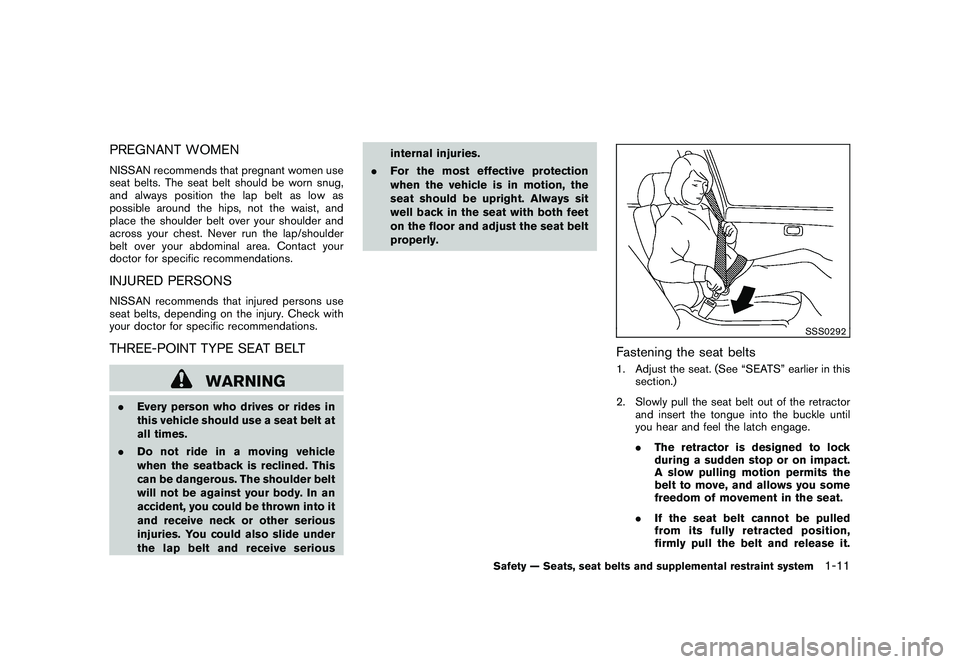
Black plate (29,1)
Model "Z34-D" EDITED: 2010/ 7/ 27
PREGNANT WOMENNISSAN recommends that pregnant women use
seat belts. The seat belt should be worn snug,
and always position the lap belt as low as
possible around the hips, not the waist, and
place the shoulder belt over your shoulder and
across your chest. Never run the lap/shoulder
belt over your abdominal area. Contact your
doctor for specific recommendations.INJURED PERSONSNISSAN recommends that injured persons use
seat belts, depending on the injury. Check with
your doctor for specific recommendations.THREE-POINT TYPE SEAT BELT
WARNING
.Every person who drives or rides in
this vehicle should use a seat belt at
all times.
. Do not ride in a moving vehicle
when the seatback is reclined. This
can be dangerous. The shoulder belt
will not be against your body. In an
accident, you could be thrown into it
and receive neck or other serious
injuries. You could also slide under
the lap belt and receive serious internal injuries.
. For the most effective protection
when the vehicle is in motion, the
seat should be upright. Always sit
well back in the seat with both feet
on the floor and adjust the seat belt
properly.
SSS0292
Fastening the seat belts1. Adjust the seat. (See “SEATS” earlier in this
section.)
2. Slowly pull the seat belt out of the retractor and insert the tongue into the buckle until
you hear and feel the latch engage.
.The retractor is designed to lock
during a sudden stop or on impact.
A slow pulling motion permits the
belt to move, and allows you some
freedom of movement in the seat.
. If the seat belt cannot be pulled
from its fully retracted position,
firmly pull the belt and release it.
Safety — Seats, seat belts and supplemental restraint system
1-11
Page 34 of 419
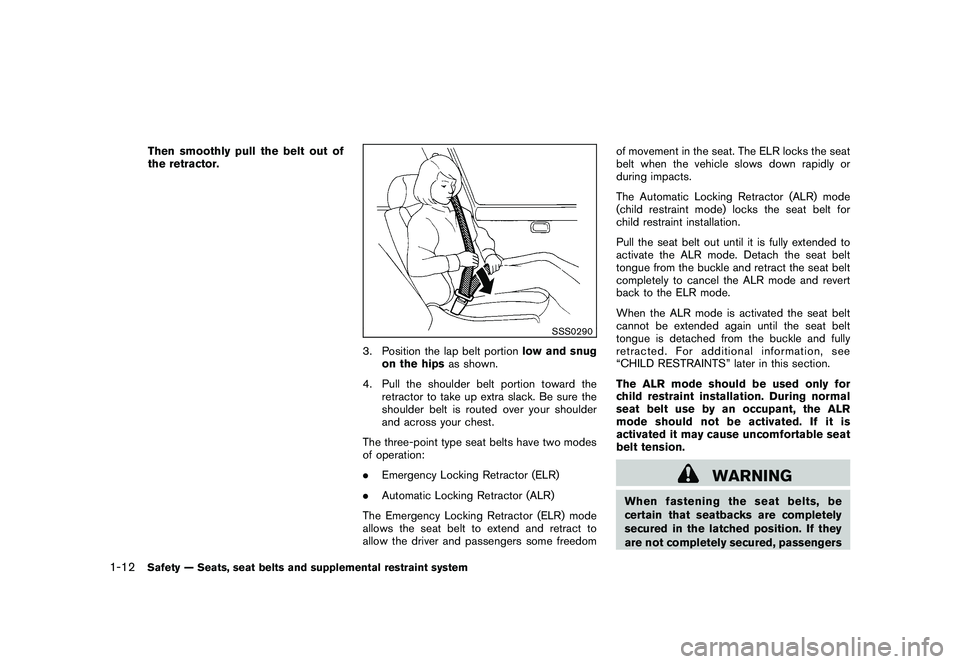
Black plate (30,1)
Model "Z34-D" EDITED: 2010/ 7/ 27
Then smoothly pull the belt out of
the retractor.
SSS0290
3. Position the lap belt portionlow and snug
on the hips as shown.
4. Pull the shoulder belt portion toward the retractor to take up extra slack. Be sure the
shoulder belt is routed over your shoulder
and across your chest.
The three-point type seat belts have two modes
of operation:
. Emergency Locking Retractor (ELR)
. Automatic Locking Retractor (ALR)
The Emergency Locking Retractor (ELR) mode
allows the seat belt to extend and retract to
allow the driver and passengers some freedom of movement in the seat. The ELR locks the seat
belt when the vehicle slows down rapidly or
during impacts.
The Automatic Locking Retractor (ALR) mode
(child restraint mode) locks the seat belt for
child restraint installation.
Pull the seat belt out until it is fully extended to
activate the ALR mode. Detach the seat belt
tongue from the buckle and retract the seat belt
completely to cancel the ALR mode and revert
back to the ELR mode.
When the ALR mode is activated the seat belt
cannot be extended again until the seat belt
tongue is detached from the buckle and fully
retracted. For additional information, see
“CHILD RESTRAINTS” later in this section.
The ALR mode should be used only for
child restraint installation. During normal
seat belt use by an occupant, the ALR
mode should not be activated. If it is
activated it may cause uncomfortable seat
belt tension.
WARNING
When fastening the seat belts, be
certain that seatbacks are completely
secured in the latched position. If they
are not completely secured, passengers
1-12
Safety — Seats, seat belts and supplemental restraint system
Page 35 of 419
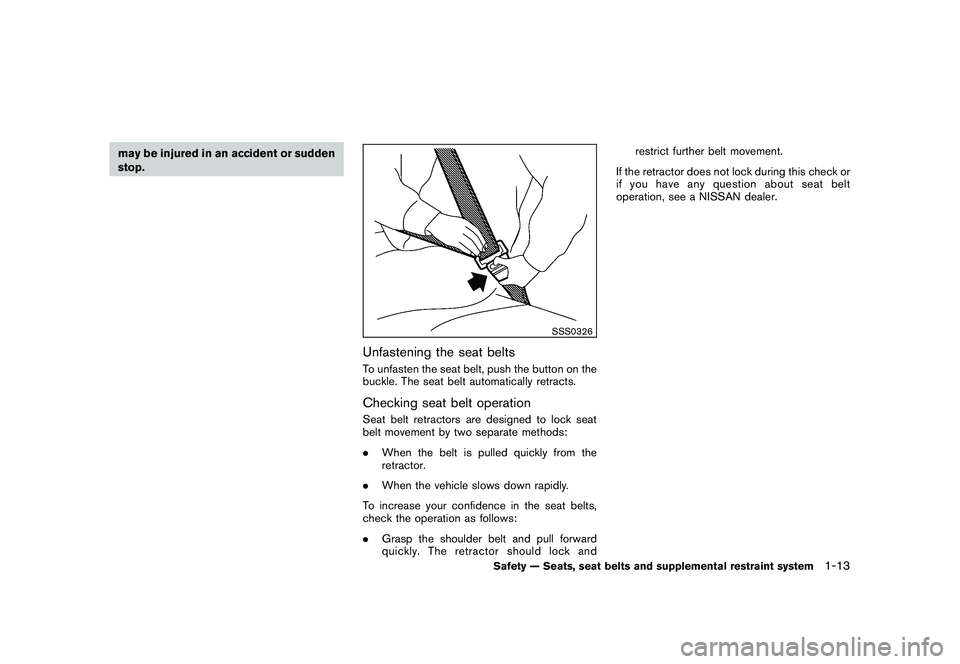
Black plate (31,1)
Model "Z34-D" EDITED: 2010/ 7/ 27
may be injured in an accident or sudden
stop.
SSS0326
Unfastening the seat beltsTo unfasten the seat belt, push the button on the
buckle. The seat belt automatically retracts.Checking seat belt operationSeat belt retractors are designed to lock seat
belt movement by two separate methods:
.When the belt is pulled quickly from the
retractor.
. When the vehicle slows down rapidly.
To increase your confidence in the seat belts,
check the operation as follows:
. Grasp the shoulder belt and pull forward
quickly. The retractor should lock and restrict further belt movement.
If the retractor does not lock during this check or
if you have any question about seat belt
operation, see a NISSAN dealer.
Safety — Seats, seat belts and supplemental restraint system
1-13
Page 36 of 419
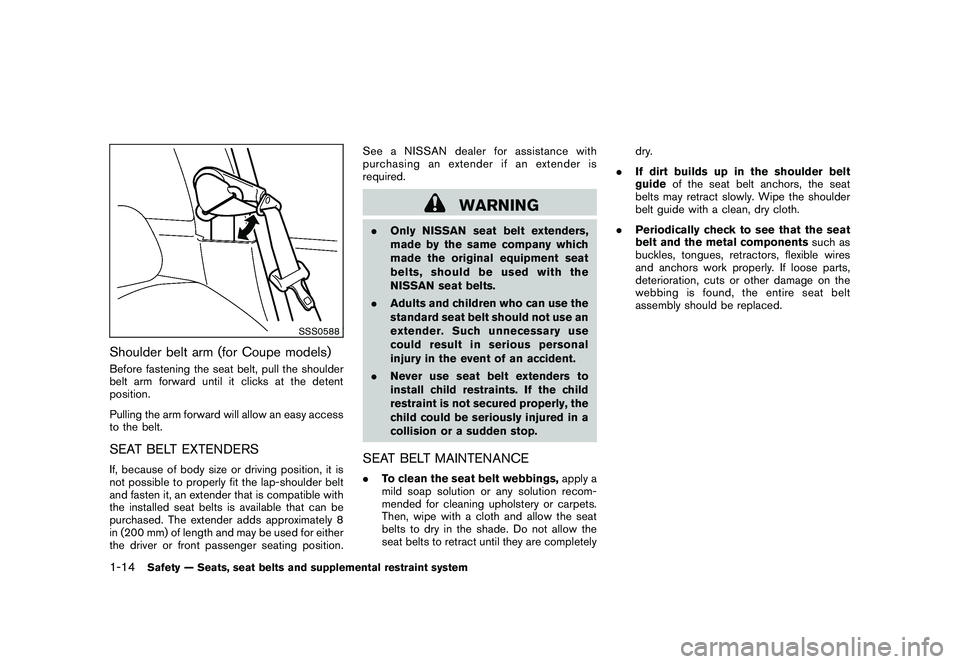
Black plate (32,1)
Model "Z34-D" EDITED: 2010/ 7/ 27
SSS0588
Shoulder belt arm (for Coupe models)Before fastening the seat belt, pull the shoulder
belt arm forward until it clicks at the detent
position.
Pulling the arm forward will allow an easy access
to the belt.SEAT BELT EXTENDERSIf, because of body size or driving position, it is
not possible to properly fit the lap-shoulder belt
and fasten it, an extender that is compatible with
the installed seat belts is available that can be
purchased. The extender adds approximately 8
in (200 mm) of length and may be used for either
the driver or front passenger seating position.See a NISSAN dealer for assistance with
purchasing an extender if an extender is
required.
WARNING
.
Only NISSAN seat belt extenders,
made by the same company which
made the original equipment seat
belts, should be used with the
NISSAN seat belts.
. Adults and children who can use the
standard seat belt should not use an
extender. Such unnecessary use
could result in serious personal
injury in the event of an accident.
. Never use seat belt extenders to
install child restraints. If the child
restraint is not secured properly, the
child could be seriously injured in a
collision or a sudden stop.SEAT BELT MAINTENANCE.To clean the seat belt webbings, apply a
mild soap solution or any solution recom-
mended for cleaning upholstery or carpets.
Then, wipe with a cloth and allow the seat
belts to dry in the shade. Do not allow the
seat belts to retract until they are completely dry.
. If dirt builds up in the shoulder belt
guide of the seat belt anchors, the seat
belts may retract slowly. Wipe the shoulder
belt guide with a clean, dry cloth.
. Periodically check to see that the seat
belt and the metal components such as
buckles, tongues, retractors, flexible wires
and anchors work properly. If loose parts,
deterioration, cuts or other damage on the
webbing is found, the entire seat belt
assembly should be replaced.
1-14
Safety — Seats, seat belts and supplemental restraint system
Page 37 of 419
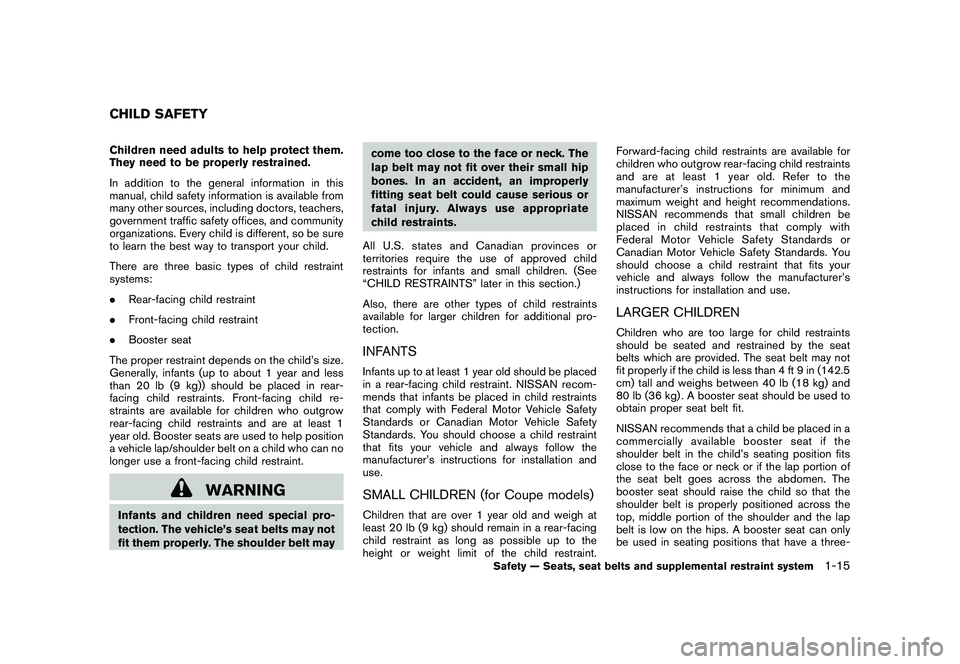
Black plate (33,1)
Model "Z34-D" EDITED: 2011/ 1/ 25
Children need adults to help protect them.
They need to be properly restrained.
In addition to the general information in this
manual, child safety information is available from
many other sources, including doctors, teachers,
government traffic safety offices, and community
organizations. Every child is different, so be sure
to learn the best way to transport your child.
There are three basic types of child restraint
systems:
.Rear-facing child restraint
. Front-facing child restraint
. Booster seat
The proper restraint depends on the child’s size.
Generally, infants (up to about 1 year and less
than 20 lb (9 kg)) should be placed in rear-
facing child restraints. Front-facing child re-
straints are available for children who outgrow
rear-facing child restraints and are at least 1
year old. Booster seats are used to help position
a vehicle lap/shoulder belt on a child who can no
longer use a front-facing child restraint.
WARNING
Infants and children need special pro-
tection. The vehicle’s seat belts may not
fit them properly. The shoulder belt may come too close to the face or neck. The
lap belt may not fit over their small hip
bones. In an accident, an improperly
fitting seat belt could cause serious or
fatal injury. Always use appropriate
child restraints.
All U.S. states and Canadian provinces or
territories require the use of approved child
restraints for infants and small children. (See
“CHILD RESTRAINTS” later in this section.)
Also, there are other types of child restraints
available for larger children for additional pro-
tection.
INFANTSInfants up to at least 1 year old should be placed
in a rear-facing child restraint. NISSAN recom-
mends that infants be placed in child restraints
that comply with Federal Motor Vehicle Safety
Standards or Canadian Motor Vehicle Safety
Standards. You should choose a child restraint
that fits your vehicle and always follow the
manufacturer’s instructions for installation and
use.SMALL CHILDREN (for Coupe models)Children that are over 1 year old and weigh at
least 20 lb (9 kg) should remain in a rear-facing
child restraint as long as possible up to the
height or weight limit of the child restraint. Forward-facing child restraints are available for
children who outgrow rear-facing child restraints
and are at least 1 year old. Refer to the
manufacturer’s instructions for minimum and
maximum weight and height recommendations.
NISSAN recommends that small children be
placed in child restraints that comply with
Federal Motor Vehicle Safety Standards or
Canadian Motor Vehicle Safety Standards. You
should choose a child restraint that fits your
vehicle and always follow the manufacturer’s
instructions for installation and use.
LARGER CHILDRENChildren who are too large for child restraints
should be seated and restrained by the seat
belts which are provided. The seat belt may not
fit properly if the child is less than 4 ft 9 in (142.5
cm) tall and weighs between 40 lb (18 kg) and
80 lb (36 kg) . A booster seat should be used to
obtain proper seat belt fit.
NISSAN recommends that a child be placed in a
commercially availabl
eboosterseatifthe
shoulder belt in the child’s seating position fits
close to the face or neck or if the lap portion of
the seat belt goes across the abdomen. The
booster seat should raise the child so that the
shoulder belt is properly positioned across the
top, middle portion of the shoulder and the lap
belt is low on the hips. A booster seat can only
be used in seating positions that have a three-
CHILD SAFETY
Safety — Seats, seat belts and supplemental restraint system
1-15
Page 38 of 419
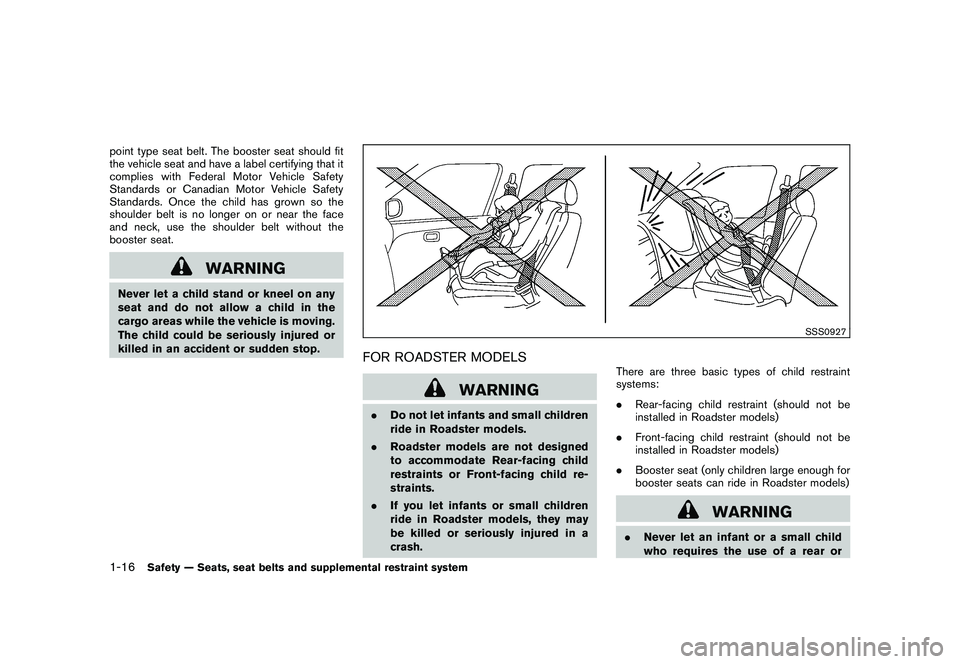
Black plate (34,1)
Model "Z34-D" EDITED: 2011/ 1/ 21
point type seat belt. The booster seat should fit
the vehicle seat and have a label certifying that it
complies with Federal Motor Vehicle Safety
Standards or Canadian Motor Vehicle Safety
Standards. Once the child has grown so the
shoulder belt is no longer on or near the face
and neck, use the shoulder belt without the
booster seat.
WARNING
Never let a child stand or kneel on any
seat and do not allow a child in the
cargo areas while the vehicle is moving.
The child could be seriously injured or
killed in an accident or sudden stop.
SSS0927
FOR ROADSTER MODELS
WARNING
.Do not let infants and small children
ride in Roadster models.
. Roadster models are not designed
to accommodate Rear-facing child
restraints or Front-facing child re-
straints.
. If you let infants or small children
ride in Roadster models, they may
be killed or seriously injured in a
crash. There are three basic types of child restraint
systems:
.
Rear-facing child restraint (should not be
installed in Roadster models)
. Front-facing child restraint (should not be
installed in Roadster models)
. Booster seat (only children large enough for
booster seats can ride in Roadster models)
WARNING
.Never let an infant or a small child
who requires the use of a rear or
1-16
Safety — Seats, seat belts and supplemental restraint system
Page 39 of 419
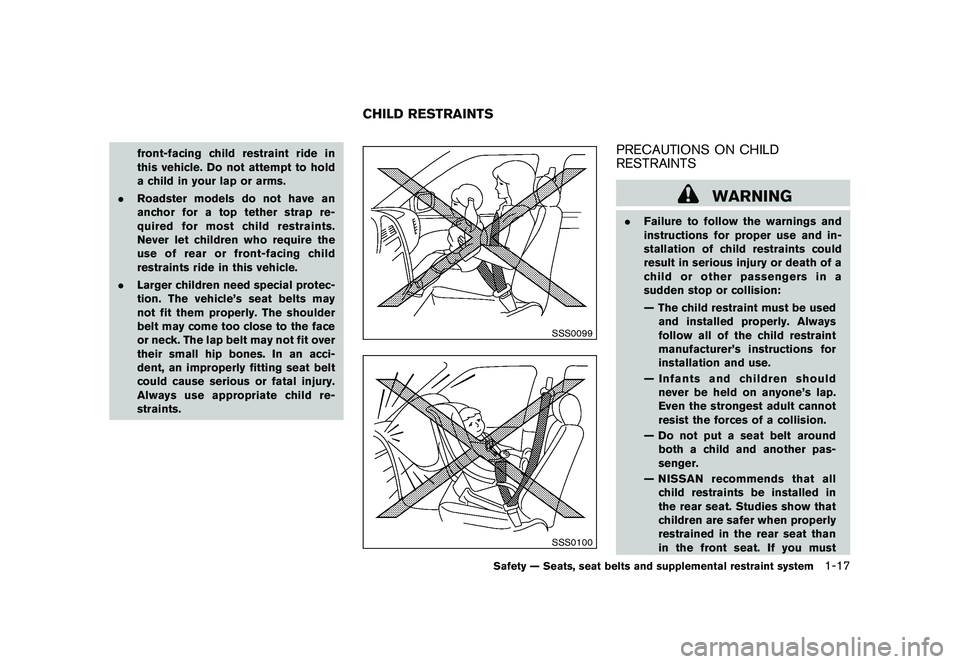
Black plate (35,1)
Model "Z34-D" EDITED: 2010/ 7/ 27
front-facing child restraint ride in
this vehicle. Do not attempt to hold
a child in your lap or arms.
. Roadster models do not have an
anchor for a top tether strap re-
quired for most child restraints.
Never let children who require the
use of rear or front-facing child
restraints ride in this vehicle.
. Larger children need special protec-
tion. The vehicle’s seat belts may
not fit them properly. The shoulder
belt may come too close to the face
or neck. The lap belt may not fit over
their small hip bones. In an acci-
dent, an improperly fitting seat belt
could cause serious or fatal injury.
Always use appropriate child re-
straints.
SSS0099SSS0100
PRECAUTIONS ON CHILD
RESTRAINTS
WARNING
.Failure to follow the warnings and
instructions for proper use and in-
stallation of child restraints could
result in serious injury or death of a
child or other passengers in a
sudden stop or collision:
— The child restraint must be used
and installed properly. Always
follow all of the child restraint
manufacturer’s instructions for
installation and use.
— Infants and children should never be held on anyone’s lap.
Even the strongest adult cannot
resist the forces of a collision.
— Do not put a seat belt around both a child and another pas-
senger.
— NISSAN recommends that all child restraints be installed in
the rear seat. Studies show that
children are safer when properly
restrained in the rear seat than
in the front seat. If you must
CHILD RESTRAINTS
Safety — Seats, seat belts and supplemental restraint system
1-17
Page 40 of 419
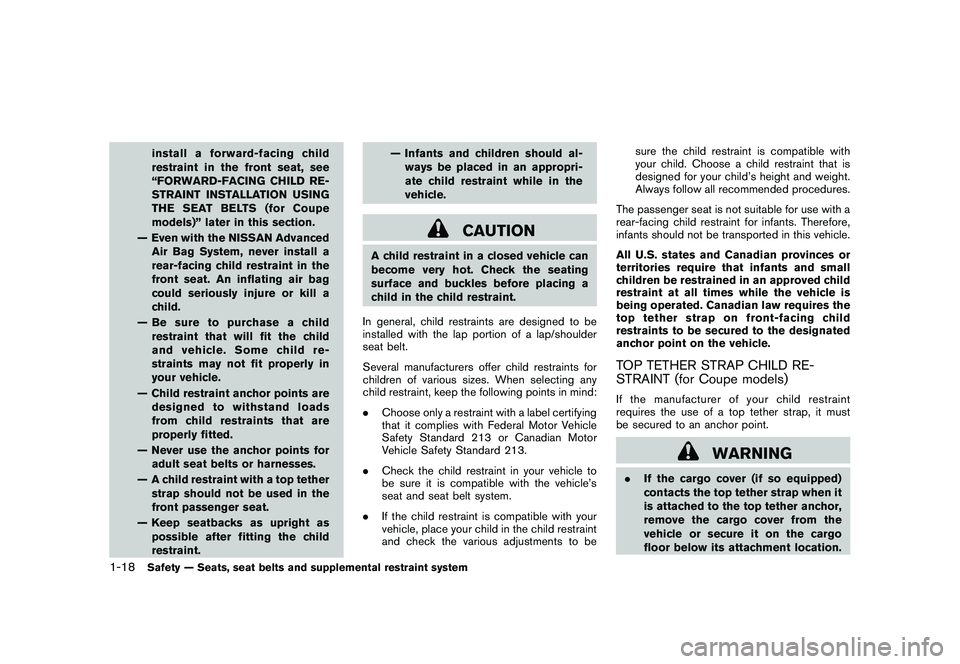
Black plate (36,1)
Model "Z34-D" EDITED: 2010/ 7/ 27
install a forward-facing child
restraint in the front seat, see
“FORWARD-FACING CHILD RE-
STRAINT INSTALLATION USING
THE SEAT BELTS (for Coupe
models)” later in this section.
— Even with the NISSAN Advanced Air Bag System, never install a
rear-facing child restraint in the
front seat. An inflating air bag
could seriously injure or kill a
child.
—Besuretopurchaseachild restraint that will fit the child
and vehicle. Some child re-
straints may not fit properly in
your vehicle.
— Child restraint anchor points are designed to withstand loads
from child restraints that are
properly fitted.
— Never use the anchor points for adult seat belts or harnesses.
— A child restraint with a top tether strap should not be used in the
front passenger seat.
— Keep seatbacks as upright as possible after fitting the child
restraint. — Infants and children should al-
ways be placed in an appropri-
ate child restraint while in the
vehicle.
CAUTION
A child restraint in a closed vehicle can
become very hot. Check the seating
surface and buckles before placing a
child in the child restraint.
In general, child restraints are designed to be
installed with the lap portion of a lap/shoulder
seat belt.
Several manufacturers offer child restraints for
children of various sizes. When selecting any
child restraint, keep the following points in mind:
. Choose only a restraint with a label certifying
that it complies with Federal Motor Vehicle
Safety Standard 213 or Canadian Motor
Vehicle Safety Standard 213.
. Check the child restraint in your vehicle to
be sure it is compatible with the vehicle’s
seat and seat belt system.
. If the child restraint is compatible with your
vehicle, place your child in the child restraint
and check the various adjustments to be sure the child restraint is compatible with
your child. Choose a child restraint that is
designed for your child’s height and weight.
Always follow all recommended procedures.
The passenger seat is not suitable for use with a
rear-facing child restraint for infants. Therefore,
infants should not be transported in this vehicle.
All U.S. states and Canadian provinces or
territories require that infants and small
children be restrained in an approved child
restraint at all times while the vehicle is
being operated. Canadian law requires the
top tether strap on front-facing child
restraints to be secured to the designated
anchor point on the vehicle.
TOP TETHER STRAP CHILD RE-
STRAINT (for Coupe models)If the manufacturer of your child restraint
requires the use of a top tether strap, it must
be secured to an anchor point.
WARNING
. If the cargo cover (if so equipped)
contacts the top tether strap when it
is attached to the top tether anchor,
remove the cargo cover from the
vehicle or secure it on the cargo
floor below its attachment location.
1-18
Safety — Seats, seat belts and supplemental restraint system